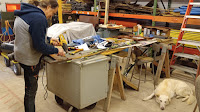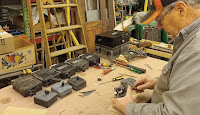Tuesday was another productive day at the Museum. I brought out the first rattan seat back that has been completed in the Hicksco factory and installed it in the 36. It sticks out because of course it's a lot cleaner than the old seats, but other than that I'd say it looks pretty realistic.
Better than the flat backs with plastic mesh.
And I now have all the seats in place in the 319, and the damaged arm rest has been replaced. I guess I didn't take a picture of it for some reason. I would have liked to paint some of the old fabric, but it never got warm enough. We're not scheduled to go into operation until late May, so painting can wait.
And while we're at Barn 8, back behind the barn we have a yard sale going on. Barn doors for sale -- cheap!!! (Cash and carry only.)
In the car shop the regulars continue to work on their projects. Here Jim is polishing parts for the 36.
Steve and Pax were prepping Liner parts.
John was cleaning, checking, and painting snap switches and MS switches for the 306.
Tim Peters was there but I didn't get a picture. And Buzz has been working on a door for the Pawnee. Here it is with fresh varnish under a dust cover. I didn't want to disturb it, so you just have to use your imagination.
Out in the shop, the 1702 is on the center track, and the 306 is over the pit:
Finally, I did some more work on the 309 motor bearing project. We should be able to install the first new bearing when the 309 is over the pit for inspection in a couple of weeks. The motor cap for that location, however, had loose alignment pins. New pins were made but they're still loose. I plan to replace it with a different motor cap from one of our spare motors. It has good pins, and this is the one I used to drill the holes in the new bearing. Motor caps should be identical, but in this business you just never know. So I have it tagged.
I also wanted to verify that this was indeed the one I had used to align the holes. It fits perfectly.
I had picked this one out of a pile of spare motor caps, going on the theory that I could infallibly tell a GE66B part from anything else. But after scraping and wire-wheeling all the dirt and grease off the part, and it indeed says "GE66B", that was a relief.
(By the way, I'm referring to this part as a "motor cap" because that's what the CA&E called it, as you can see from the third picture at this link. But we have usually called it an "axle cap", and that's fine too. I don't want to argue. "Axle cap" might be a North Shorism. Or a Dave Shorism, who could tell?)












Motor support caps are not identical. Each one is line bored to the motor and unique.
ReplyDeleteRandy Stahl
Well, Randy, I don't want to start an argument and lose an old friendship over a minor technical point, but I don't believe that's true for the antique mechanical parts I'm talking about. What you say may well be true for modern diesels. I wouldn't know.
ReplyDeleteIf you look at the blueprint I linked to, the only two machined surfaces I can see are the bottom face of the cap (to prevent oil leakage) and the face that butts up against the shoulder of the bearing. Everything else was about as unique as castings ever can be. Based on what I know of shop practices at Wheaton, they didn't have unique parts for every motor. And I'm sure that for our conditions of service this motor cap will be an improvement.
But we're always glad to get input from experts. Keep it coming!
I think your key statement is that your conditions may not be enough to cause an issue. I would be aware of bearing temps however. On freight locomotives it is imperative to keep correct line bore, granted, a much more demanding service.
ReplyDeleteRandy
There are two issues here. The outer diameter of the bearing has to match the inner diameter of the cap and motor, or you risk cracking the bearing. But there's no friction, so nothing should ever wear out. On the other hand, the axles are rotating against the inner diameter of the bearings, and that's where all the wear takes place. You would probably be shocked at how loose a lot of the bearings we use in regular service are! That's why I want to have new bearings cast for the 309. But generally speaking, I would expect that GE66B motor caps are interchangeable.
ReplyDeleteOur service at the Museum shouldn't ever cause bearings to overheat. But we have temperature sensors to check for problems when changes are made. And if we can ever get the new bearings installed, we'll be checking that, I promise. Thanks!
The picture of “Phil” polishing Electroliner parts is actually Jim Scanlon says Paul Hough
ReplyDeleteHi, I agree with Randy. Axle bearing caps are not interchangeable. When they were boring the motor case the bore for the armature was bored first. Then, using the correct gear center dimension, they would bore the hole for the axle bearings. If the center of that bore was exactly on the split line, they were just lucky. If the bore was not centered exactly of the split line, one side is a little larger that the other. If you change caps, you could get two smaller half’s and when the bearing axle cap is bolted tight the gap will not close. If you get two large half’s, when bolted up tight, the bearings will still be loose. Use Locktite bearing retaining product, maybe 640, and lock in the pins. Follow the Locktite instructions. Clean off all the oil with acetone and then use the Locktite primer. Then allow the material to harden for about 24 hours before installing the bearings. In more modern motors, that bore is bored with a shim clamped in the split. Then the shim thickness can be adjusted to get interchanged caps to fit properly. See the EMD MI on repairing worn out bearing axle caps and they explain the process on rebuilding the caps. If you can not find the MI, let me know and I will look the number up. I am sure your Diesel department will have copies of it.
ReplyDeleteDavid Johnston
While tolerances are strict for locomotives,, I agree with Randy that using loose fitting undersized bearings would make line bore more or less irrelevant. Gear noise might be an issue but without new axles, new or rebuilt caps, and new bearings and a new line bore, I don’t think I’d worry about a machine that sees maybe 200 miles a year with much of that time with the motor unloaded. Unloaded the support bearing has only to support the weight of the traction motor and no axial torque. As long as the bearing have some Babbitt on them it shouldn’t act like a machine tool cutter on the axle.
ReplyDeleteRandy Stahl
I agree with Randy also. In this discussion, who wouldn't???
ReplyDeleteAnd thanks for the correction about Jim Scanlon. Sorry!